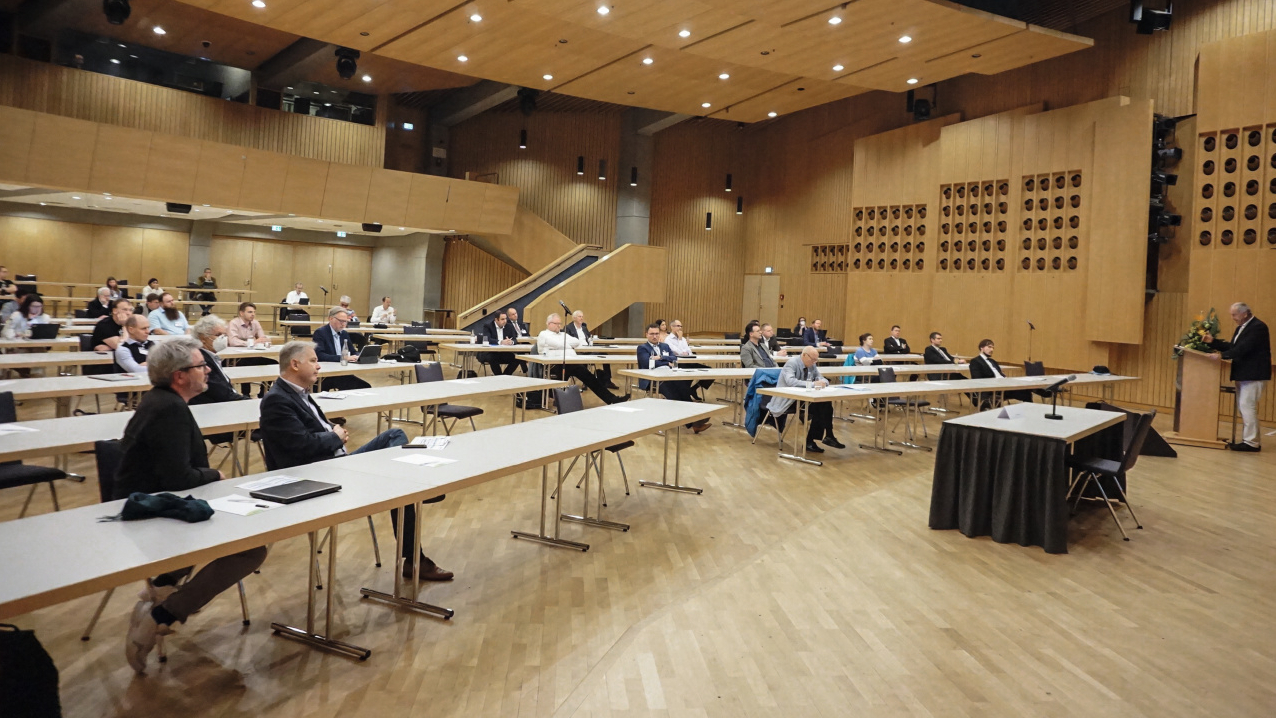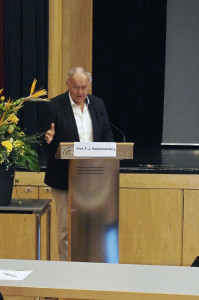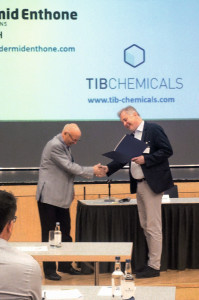TheUlmer Gespräch 2022 from May 4-5, 2022 in Neu-Ulm with a focus on "Sustainability and climate neutrality - challenges and opportunities for electrochemical processes and electroplating" in retrospect.
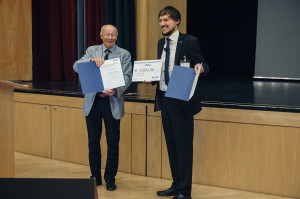 Dr. Martin Leimbach from Ilmenau University of Technology received the Nasser Kanani Prize, endowed with 3000 euros, for his work on the production of high-quality chromium III coatingsSurfacetechnology is a cross-sectional technology for the entire industrial sector. This sentence was one of the first to be uttered by event director Prof. Wolfgang Paatsch at the first "Ulm Talk" after two years of the coronavirus pandemic. And as befits a cross-sectional technology, the event on May 4 and 5, which was still rather sparsely attended with just over 60 visitors, probably also offered a much broader range of topics compared to the past. The topics included climate and sustainability considerations, battery technologies and renewable energies, decarbonization and digital networking in surface technology, to name just a few. At the same time, the choice of topics was in line with the event's focus on sustainability and climate neutrality.
Dr. Martin Leimbach from Ilmenau University of Technology received the Nasser Kanani Prize, endowed with 3000 euros, for his work on the production of high-quality chromium III coatingsSurfacetechnology is a cross-sectional technology for the entire industrial sector. This sentence was one of the first to be uttered by event director Prof. Wolfgang Paatsch at the first "Ulm Talk" after two years of the coronavirus pandemic. And as befits a cross-sectional technology, the event on May 4 and 5, which was still rather sparsely attended with just over 60 visitors, probably also offered a much broader range of topics compared to the past. The topics included climate and sustainability considerations, battery technologies and renewable energies, decarbonization and digital networking in surface technology, to name just a few. At the same time, the choice of topics was in line with the event's focus on sustainability and climate neutrality.
Before the presentations began, however, the first Nasser Kanani Award ceremony was on the agenda. Prof. Kanani is known in the industry for his numerous specialist books and awards. He is a professor at the TU Berlin. The prize he donated for advances in electrochemical surface technology is endowed with 3000 euros and went to Dr. Martin Leimbach from the TU Ilmenau, who received it for his work on the characterization of the electrochemical deposition of decorative chromium III. The insights he gained are worthy of the prize in that they contribute to a greater understanding of process-related color differences in electroplated chromium layers. He demonstrated that a combination of direct current deposition and short pulse deposition produces high quality chromium III coatings. When it comes to occupational safety, chromium III coatings are significantly less harmful than conventional chromium VI coatings. Leimbach's findings are therefore not only technologically groundbreaking, but are also interesting in the context of sustainable production.
Prof. Franz-Josef Radermacher from the Research Institute for User-Oriented Knowledge Processing in Ulm then addressed the participants and spoke about the mobility of the future. He took a critical view of a narrow focus on electromobility and reminded the audience that climate-neutral mobility is also possible with the help of synthetic fuels, which Porsche, for example, wants to produce together with partners in Chile. In order to counter "the explosion ofCO2 emissions and the corresponding consumption of resources", Radermacher proposes an approach as a holistic solution for reducing emissions worldwide, which is now also occasionally appearing in public debate: the capture ofCO2 from industrial processes. This could be stored and used as an energy source. A proposal that is probably only possible through a global effort and the use of state-of-the-art technology.
Industry representatives received Radermacher's thoughts thoughtfully, as the subsequent lunch break showed. After all, the scientist with contacts at the Club of Rome sustainability initiative and former development aid minister Gerd Müller had calculated, among other things, that the production of green hydrogen would not meet industrial demand and that the climate targets, such as limiting global warming to +1.5 or 2 degrees, could not be realistically met. However, discussions on the fringes of the conference showed that the urgency of an industrial transformation towards more climate-friendly production is fundamentally undisputed in the industry, even if there are currently concerns about maintaining the gas supply due to the war in Ukraine, which remains essential as a bridging technology in the energy sector.
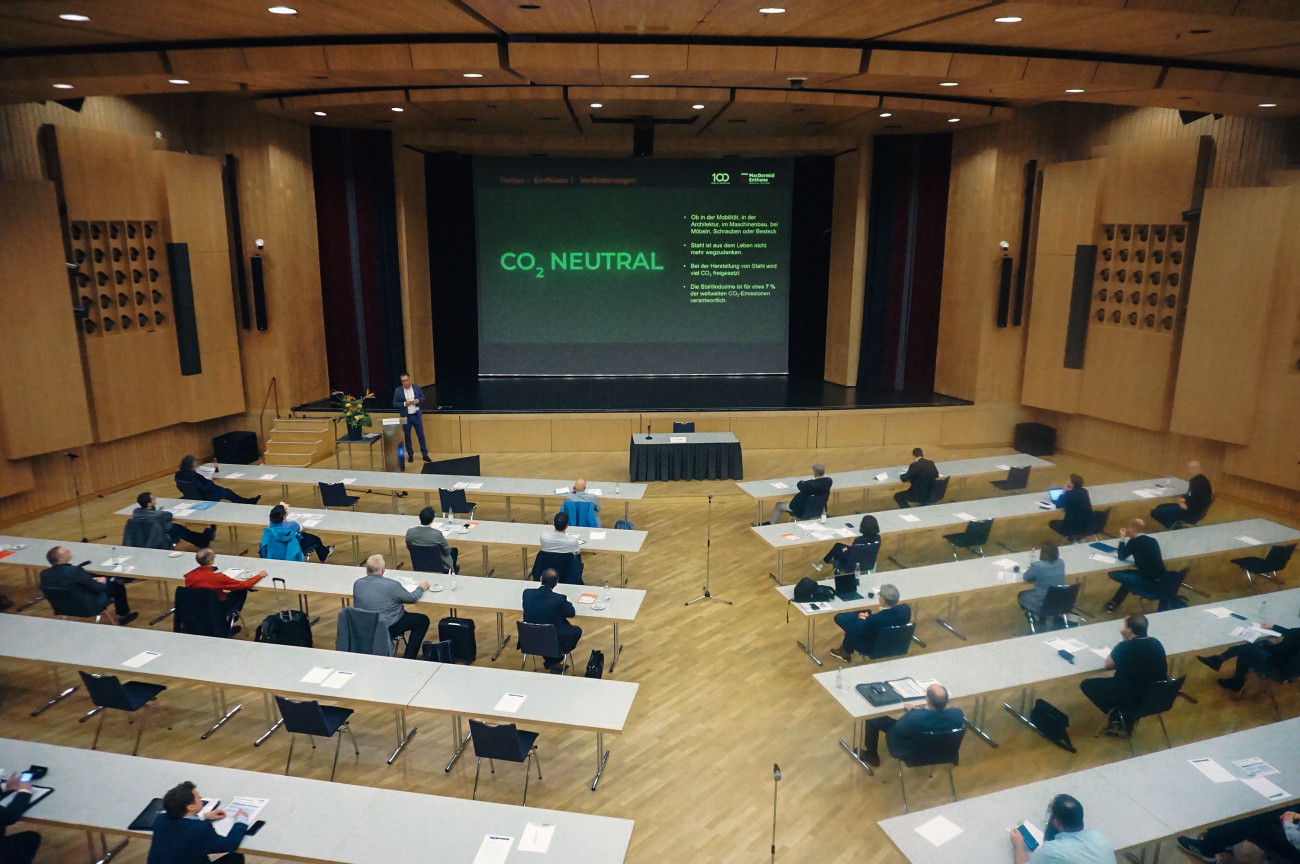 Conference hall during the lecture by Karl Joachim Becker, who spoke about reducing energy consumption by lowering bath voltages in electroplating plants, among other things
Conference hall during the lecture by Karl Joachim Becker, who spoke about reducing energy consumption by lowering bath voltages in electroplating plants, among other things
The following presentations by Dr. Peter Fischer from the Fraunhofer Institute for Chemical Technology ICT in Pfinztal and Dr. Michael Roscher from Liovolt GmbH in Limbach-Oberfrohna focused on modern battery technologies, with the latter also presenting methods for the deposition of electroplated copper and nickel layers on aluminum foils. These could serve as a replacement for roll-coated conductor foils. This was followed by Dr. Holger Kühnlein from the manufacturer of wet-chemical systems Rena Technologie in Freiburg. He described an electrochemical wafering process based on silicon carbide. Instead of screen printing silver, electrochemical contacting with a nickel-copper alloy can also be used for metallization. Dr. Kühnlein calculated that 20 tons of silver are currently used for solar cells with a capacity of 1 GW. 120 GW would then already account for 10 % of the global silver supply. Prof. Andreas Bund from the TU Ilmenau chaired the discussion of this first topic block.
 The chair of the discussion changed after every two or three presentations. On the second day, the new Technical DGO Managing Director Dr. Daniel Meyer led several speeches in connection with electrochemistry and the recycling of metals, particularly with regard to raw material efficiency. Electrochemistry makes it relatively easy to recover metals from e-waste and rare earth magnets, for example, as Klaus Schmid from the Fraunhofer Institute for Manufacturing Engineering and Automation (IPA) in Stuttgart explained. There is obviously great interest in this: companies such as Bosch, BASF and Veolia are represented in the project. Dr. Sabrina Zellmer from the Fraunhofer Institute for Surface Engineering and Thin Films IST in Braunschweig then spoke about battery recycling. Katja Feige from Fraunhofer IPA led the discussion on the recycling topic.
The chair of the discussion changed after every two or three presentations. On the second day, the new Technical DGO Managing Director Dr. Daniel Meyer led several speeches in connection with electrochemistry and the recycling of metals, particularly with regard to raw material efficiency. Electrochemistry makes it relatively easy to recover metals from e-waste and rare earth magnets, for example, as Klaus Schmid from the Fraunhofer Institute for Manufacturing Engineering and Automation (IPA) in Stuttgart explained. There is obviously great interest in this: companies such as Bosch, BASF and Veolia are represented in the project. Dr. Sabrina Zellmer from the Fraunhofer Institute for Surface Engineering and Thin Films IST in Braunschweig then spoke about battery recycling. Katja Feige from Fraunhofer IPA led the discussion on the recycling topic.
At the evening event in the Drei Kannen brewery in Ulm, attendees were able to enjoy the benefits of a face-to-face event with personal conversations and discussions on the current situation over good food - for many of the researchers, entrepreneurs and DGO association representatives who attended, it was the first time since the restrictions imposed by the coronavirus pandemic in the past two years. There was also a large group of Coventya representatives, who have been part of the former competitor MacDermid Enthone for some time now and presented themselves in Ulm for the first time under the new company name.
Karl Joachim Becker, a member of this group, also gave the first presentation the next day. This time, the new DGO Technical Managing Director Dr. Daniel Meyer chaired the discussion of the first thematic block on "Operations/Energy/Energy Management". Using the example of 3S anodes in alkaline zinc-nickel electrolytes, Becker described how power consumption can be reduced and efficiency increased. TheCO2 reduction can amount to a maximum of 75 %. The reasons for this include a lower bath voltage and improved electrolyte conductivity. The method of using the hydrogen produced, which Stefan Funk from the Research Institute for Precious Metals + Metal Chemistry (fem) then presented, is interesting but also involves risks. One example was the anodizing of aluminium components, which produces a lot of hydrogen at the cathode. A controlled oxyhydrogen reaction generates heat, which can be used in the subsequent compression process. However, precise control is essential to avoid an explosion. A presentation from the practice of Saxonia Galvanik from Halsbrücke then described the possibilities of energy optimization through an energy management system in accordance with the ISO 50001 standard. A savings potential of 610 MWh was determined for heat and 717 MWh for electricity; leaks were also checked and leaks discovered. The company is preparing for climate neutrality in Scope 1 and 2 by 2030.
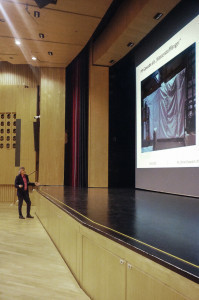 Hydrogen use in anodizing: Stefan Funk from fem presented a method using a controlled oxyhydrogen reactionUnderthe chairmanship of Dr Heidi Willing from fem, the discussion then turned to decarbonization. Two presentations by Florian Ansgar Jaeger from Siemens and Jan Mehlberg from MW Enamic dealt with theCO2 footprint for the carbon footprint that all companies will soon have to submit on their way to climate neutrality.
Hydrogen use in anodizing: Stefan Funk from fem presented a method using a controlled oxyhydrogen reactionUnderthe chairmanship of Dr Heidi Willing from fem, the discussion then turned to decarbonization. Two presentations by Florian Ansgar Jaeger from Siemens and Jan Mehlberg from MW Enamic dealt with theCO2 footprint for the carbon footprint that all companies will soon have to submit on their way to climate neutrality.
have to submit on their way to climate neutrality. Jaeger presented a system from Siemens that includes all emissions data along the supply chain, while Mehlberg described a holistic approach to decarbonization.
Dr. Andreas Dietz from the Fraunhofer IST, who had previously been honored by Prof. Paatsch with a medal and certificate for his 25 years of DGO membership, led the discussion in the last topic block. First, Felix Pag from the University of Kassel presented the possibilities of solar thermal energy, i.e. the conversion of solar energy into thermal energy, which Pag particularly emphasized. He presented various companies from the paint processing and electroplating sectors that are already using solar thermal energy. The last two presentations were somewhat out of the ordinary with their topics of digitalization and metals as fuels, but offered connections to surface technology and electrochemistry. While Edgar Kaufmann from B+T, Hüttenberg, highlighted the opportunities of digital networking in surface technology, Volker Weiser from Fraunhofer ICT spoke about metals as storable energy sources that can be converted into electricity. The reaction products can be recycled using electrochemical processes.
Prof. Paatsch concluded the event with a somewhat different character than usual and underlined the opportunity and challenge of the industrial transformation towards climate neutrality by referring once again to Radermacher's keynote speech. He had presented the topic relentlessly, "but also showed rays of hope!" The date for the Ulm Talk 2023 has not yet been set, but the event is expected to take place as usual in May next year.

